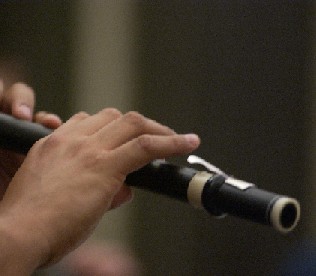The question for the week (or lifetime) is:
What can we do to put extended, technically demanding passages in our comfort zones and make music in the process?
In other posts I've discussed the benefits of
practicing slowly, to the point where one may play the entire passage or movement without any note errors. The same with practicing short segments of the passage, both forwards and backwards. And while doing all of this, other elements to practice are the practices of being aware of what your body is doing. By this I mean what your fingers are doing for every note, how your embouchure changes from register to register (or even from note to note, especially in large leaps), how your breathing mechanism moves or reacts, and what your musical mind is doing as you work through the phrase. This is a lot to think about while playing a piece of music. But let us first determine the difference between practicing and playing. Practice is often thought of as not fun; I try to view it as meditative, the process of trying to achieve some sort of musical enlightenment (the Zen of flute playing, so to say).
Because it is a lot to process, that is why the practice is to be done slowly. Slow. Very slow. Unbelievably slowly. We are learning to control our environment, from how little our fingers need to move to how much air we need to take in on one big or a few small breaths in rapid succession before the passage begins, to keeping our musical mind focussed on the music, the phrase, the goal notes in the harmonic function and their relationship to the bass line (when applicable). Think of this as setting up a base camp before making the final ascent towards the rhetoric of the music.
Once we start this process, there are even more things to consider, and different people have different ways of getting to the comfort zone base camp. After getting comfortable with where all the notes go in the passage, and we have figured out which of our fingers are behaving radically, that is, pointing at the ceiling when they don't have to, we can start developing some speed and identifying goal notes/rest stops/water stations/etc. A good thing to do is to slur the entire passage at various speeds (taking air when needed). This will tell you right away what note combinations and finger movements are uneven. It may seem illogical, to try to even out a passage when we ultimately want it to swing, but the
notes inegales should happen on purpose and when you want them, not because of an uneven finger technique. This is all part of building our foundation, on which to build the musical structure. How many other ways may I describe this? Base camp, foundation, starting point, and . . .
OK, now that we've slogged through the meditative aspect of the music, we can start to engage the rhetoric. What exactly is rhetoric? In today's wacky political climate the word or term gets applied, erroneously, to all sorts of things. Historically speaking, it means two things, and two things only: the art of speaking well, and the art of speaking persuasively. For our music making, we want to speak well and persuasively. We have a story to tell, essentially. How the story is told is up to the individual story teller, presenter, musical orator, player, etc.
One could tell the same story over and over with many different interpretations. Regardless of your interpretation, you have to be clear, consistent, and convincing. This is where your magic bag of tools comes into play, your articulations, including slurs (yes, they are "allowed" in Baroque music), and the huge array of other punctuations, such as dots, strokes, slashes, and just plain, unmarked notes. Going back to the practice part, the slow practice, now that you can play all the notes without flinching or missing them, it is time to engage the various rhetorical tools from our bag of tricks ("If I only had my magic bag . . . "). You may still feel as if you are slogging but hopefully you will be slogging with a purpose and you won't be worrying about what your body needs to do; it will be doing it. I really do approach things this way, which occasionally drives my wife into her sewing room.
That's all I have for today. Let's hear your thoughts, experiences, frustrations, and any questions or related topics. Blogs away!
